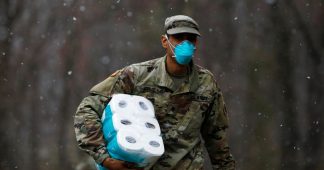By Gregor Link
Oct. 28, 2020
Over recent days, well over 11,000 people have been infected each day with coronavirus in Germany. The Robert Koch Institute (RKI), Germany’s disease control agency, reported 14,714 cases on Saturday on the basis of data supplied by local health authorities. Both previous days saw over 11,200 new cases registered, while there were 11,176 on Sunday and 8,685 on Monday. However, due to the reduced processing of tests in some local health authorities over the weekend, the real number of infections on Sunday and Monday is likely much higher.
Overall, average new infections are twice as high as they were at the end of March and beginning of April when the pandemic reached its initial high point with between 5,000 and 7,000 daily cases.
The available data shows that the drive by the federal and state governments to reopen the economy and systematically encourage the mass infection of the population is threatening the health and lives of hundreds of thousands. It will culminate in a matter of weeks in a catastrophic collapse of Germany’s hospital networks unless a sharp change of course is initiated with the shutdown of schools and the economy.
In its situation report on Sunday, the RKI noted that 71 cities and districts had infection rates of 100 per 100,000 inhabitants or higher and are therefore potential hotspots. The share of those infected who have died in Germany was calculated by the RKI at 2.3 percent.
The current lower empirical death rate of 1 percent, the institute added, threatens to rise sharply in the coming days. The situation report commented on this, “However, the infections among elderly people is increasing. Because they tend to experience more serious symptoms from COVID-19, the number of serious cases and deaths will also rise.” The institute called for the spread of the coronavirus to be prevented.
As Der Spiegel reported last week, the actual number of infections in Germany is systematically underestimated by the RKI’s published figures. “The most important number in the pandemic, the new infections within the past seven days, is often falsely recorded by the RKI,” wrote the newsmagazine. In the time period under review, at least 30 percent of these figures were incomplete and therefore flawed, because “the data from at least one day were completely” missing. The differential varied across states but was as high as 25 percent, an effect that can under-represent the exponential spread of the pandemic.
With the explosion of new infections, the number of patients being brought into intensive care units is also increasing. As the Tagesschau reported, the number of intensive care patients has almost doubled from 690 to 1,121 in just a week. The figure two weeks ago was 510, and just 293 patients one month ago. This is typical of exponential growth.
Of the 487 patients currently on ventilators nationwide, statistics suggest that more than half will die. Coronavirus patients now account for 4 percent of all patients in Germany. Just 26.4 percent of intensive care beds remain unoccupied.
Speaking to the Tagesschau, Uwe Jansens, president of the German Interdisciplinary Association of Intensive and Emergency Care (DIVI) warned that there will be a shortage of health care staff during the winter. In fact, this shortage could be reached much more quickly. In France, where developments are approximately two weeks ahead of Germany, approximately 2,000 patients are being brought into hospital each day.
Health Minister Olivier Veran stated on Twitter that one coronavirus patient is hospitalized every minute. Tagesspiegel reported on figures from a study by the French professional association of nurses, which showed that 57 percent are on the verge of burnout. Prior to the pandemic, this figure was 33 percent.
Published at https://www.wsws.org/en/articles/2020/10/28/scie-o28.html











